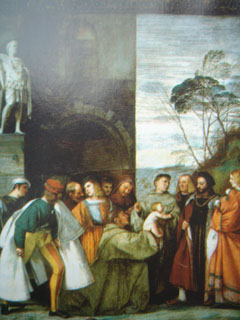Today is the feast day of St Anthony of Padua, so this week’s painting is a depiction of one of his miracles, The Miracle of the Speaking Babe. It was painted by the Venetian artist Titian in 1511 and can be found in the Scoletta del Santo, the ancient house of the Confraternity of Saint Anthony, closely attached to the basilica dedicated to the Franciscan friar in Padua. St Anthony is the city’s patron saint and his cult remains strong there. The basilica continues to be a popular site of pilgrimage, especially at this time of year, much visited by those who would venerate the many relics of the saint – including, if memory serves me right, several teeth and fingernails as well as an impressively large jawbone – which are still preserved in reliquaries in its treasury.
The Miracle of the Speaking Babe is one of Titian’s first reliably documented and dated works. Painted using the fresco technique, in colours that have somewhat darkened over the passage of time, the picture has long fascinated students of this great painter’s work precisely because it can be placed with certainty so early in his career. Already, Titian has begun to develop his own highly original approach to narrative painting. In this painting we can, so to speak, see him stepping out of the long shadow cast by his great Venetian predecessor Giovanni Bellini and becoming his own man. The statuesque grandeur of this group of figures is reminiscent of Bellini, and so is the verdant landscape behind them, with its gracefully silhouetted trees against a faded sky. But the intense restraint of Bellini, the deeply contemplative decorum which infuses his paintings and seems to freeze his figures into an eternity of stilled meditation – Titian has suddenly and sharply...


